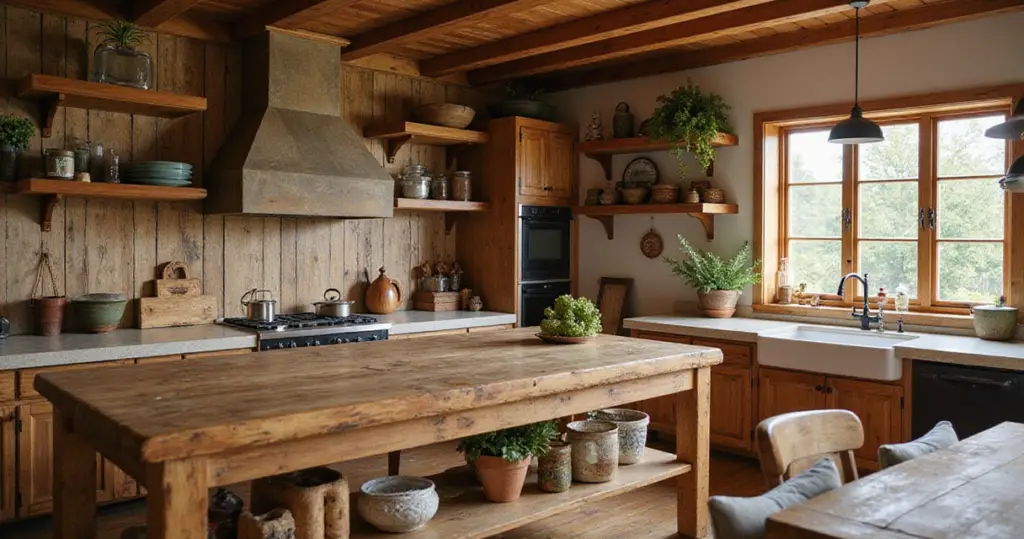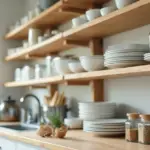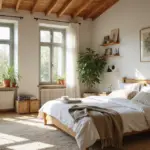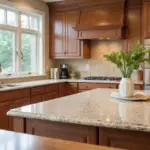Stepping into a kitchen where weathered wood tells stories of generations past, where the gentle patina of well-loved surfaces invites touch, and where every element seems to whisper of simpler times – this is the magic of rustic kitchen design. As someone who’s spent years integrating natural growing systems into urban homes, I’ve witnessed firsthand how authentic materials and thoughtful design can transform a sterile cooking space into the nurturing heart of a home.
The beauty of rustic design lies not in perfection, but in the celebration of natural imperfections that speak to our deep connection with the earth. Whether you’re cultivating herbs on reclaimed wood shelves or preparing farm-fresh meals on a butcher block island, these spaces honor both our agricultural heritage and our modern need for functional beauty. In our increasingly digital world, the kitchen becomes our sanctuary – a place where we can literally and figuratively ground ourselves through the ritual of nourishing our families.
These 18 essential rustic kitchen design ideas will guide you in creating a space that feels both timelessly authentic and perfectly suited to contemporary life. From sustainable material choices that support local ecosystems to integrated growing spaces that bring the garden indoors, each element works together to create a kitchen that’s not just beautiful, but deeply connected to the natural world around us.
1. Embrace Reclaimed Wood for Authentic Character
Reclaimed wood carries within its grain the stories of barns that sheltered livestock, factories that powered communities, and homes that housed generations of families. When you incorporate these weathered planks into your rustic kitchen design, you’re not just adding a material – you’re weaving history into your daily life. The nail holes, saw marks, and natural weathering create a depth of character that new lumber simply cannot replicate, instantly grounding your space in authentic warmth.
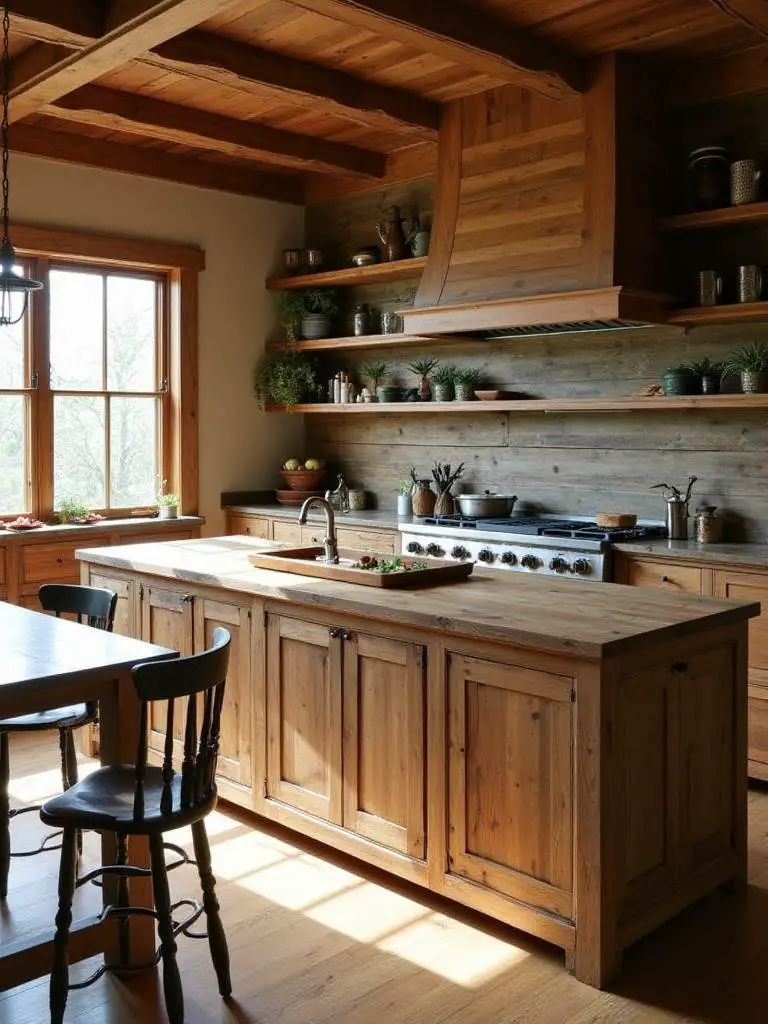
Beyond its undeniable visual appeal, reclaimed wood offers practical benefits that align perfectly with sustainable living principles. This material typically comes from old-growth trees, making it denser and more stable than today’s fast-growth alternatives. It’s already been seasoned by decades of use, meaning less shrinkage and warping in your kitchen environment. Plus, choosing reclaimed wood diverts materials from landfills while reducing demand for new timber harvesting – a choice that resonates with anyone committed to environmental stewardship.
Key benefits of reclaimed wood:
- Superior stability from natural aging process
- Unique character marks that tell authentic stories
- Environmental sustainability through material reuse
- Natural resistance to moisture and temperature changes
The craftsmanship behind this technique reveals itself in details like the hand-hewn texture variations and the rich patina that develops over time.
2. Install Butcher Block Counters for Natural Warmth
There’s something deeply satisfying about preparing meals on a surface that breathes with the seasons, develops character through use, and can be renewed with simple care. Butcher block countertops bring an organic warmth to rustic kitchen design that stone and synthetic materials simply cannot match. As someone who’s designed countless growing spaces, I can attest that wood surfaces create a more nurturing environment for food preparation – they’re gentler on knives, naturally antimicrobial when properly maintained, and develop a beautiful patina that tells the story of countless family meals.
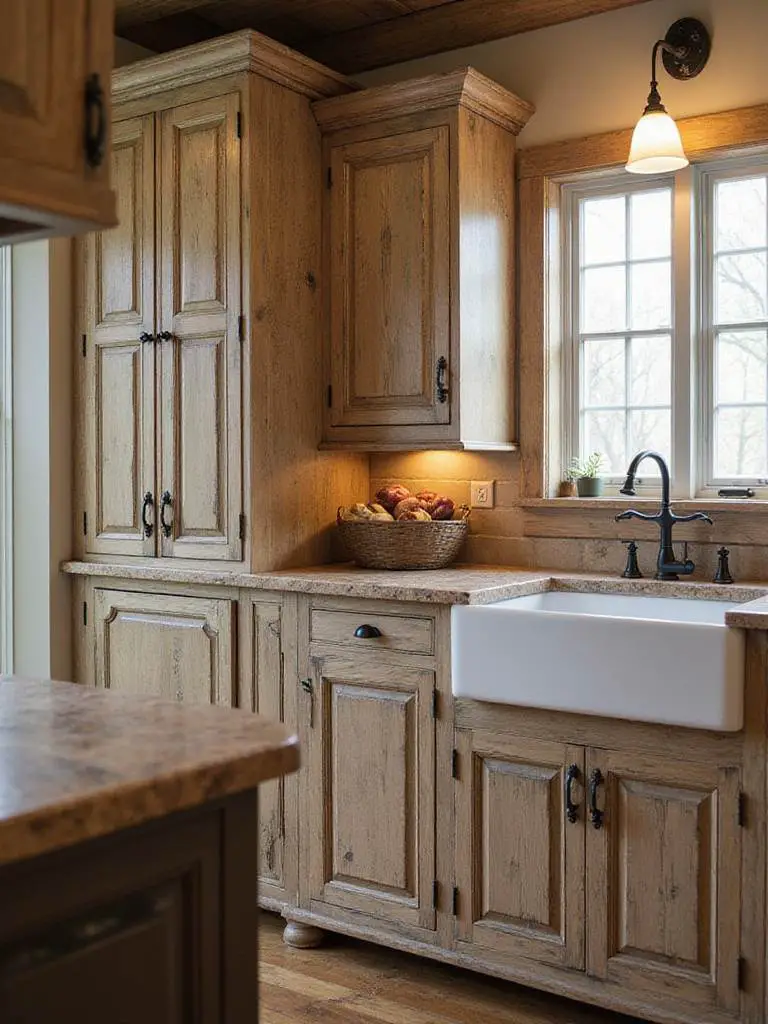
The practical advantages of butcher block extend far beyond aesthetics. Unlike granite or quartz, minor scratches and stains can be sanded out and the surface re-oiled, essentially giving you a renewable countertop that can last decades. Wood also provides natural cushioning that reduces fatigue during long cooking sessions and creates a warmer surface temperature that’s more comfortable to work on. For families who do serious cooking and preserving, butcher block offers the durability to handle heavy use while maintaining its welcoming character.
Essential maintenance tips:
- Oil monthly with food-safe mineral oil or beeswax blend
- Sand lightly and re-oil annually for deep conditioning
- Clean spills immediately to prevent staining
- Use cutting boards for raw meat to maintain hygiene
What makes this choice better for our planet is the renewable nature of responsibly harvested hardwoods and the longevity that reduces replacement needs.
3. Choose a Classic Farmhouse Sink for Functional Beauty
The deep, generous basin of a farmhouse sink speaks to an era when kitchens were the true working heart of the home – places where vegetables from the garden were washed, preserves were prepared in large batches, and even the family’s laundry found its way through these sturdy vessels. In today’s rustic kitchen design, these sinks continue to serve as both functional workhorses and beautiful focal points, their exposed apron fronts creating an immediate sense of authentic farmhouse character.
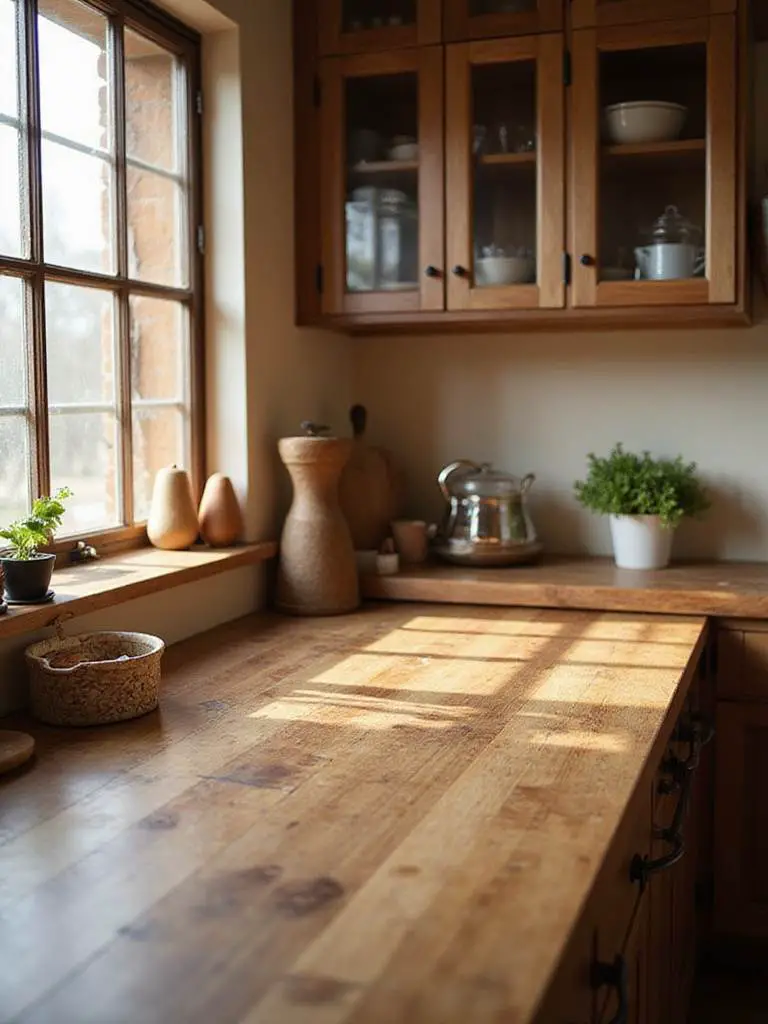
Modern farmhouse sinks combine traditional aesthetics with contemporary convenience, offering depths that easily accommodate large stockpots and roasting pans while reducing splashing during daily tasks. The forward-positioned design brings the work surface closer to your body, reducing back strain during extended food preparation sessions. Whether you choose classic white fireclay, warm copper that develops a living patina, or durable cast iron, these sinks anchor your kitchen’s rustic aesthetic while providing the functionality needed for serious cooking and preserving.
The environmental story behind this piece began with artisans who understood that quality craftsmanship creates objects meant to last generations rather than seasons.
4. Select Wide-Plank Wood Flooring for Grounded Elegance
Walking across wide-plank wood flooring in a rustic kitchen feels like stepping back in time to an era when floors were crafted from the heartwood of old-growth forests, each plank carefully selected for its strength and beauty. These expansive boards, typically six inches or wider, create a sense of spaciousness and permanence that narrow strip flooring cannot achieve. The fewer seams and longer sight lines make even modest kitchens feel more generous while providing a stable foundation that complements the organic textures of rustic design.
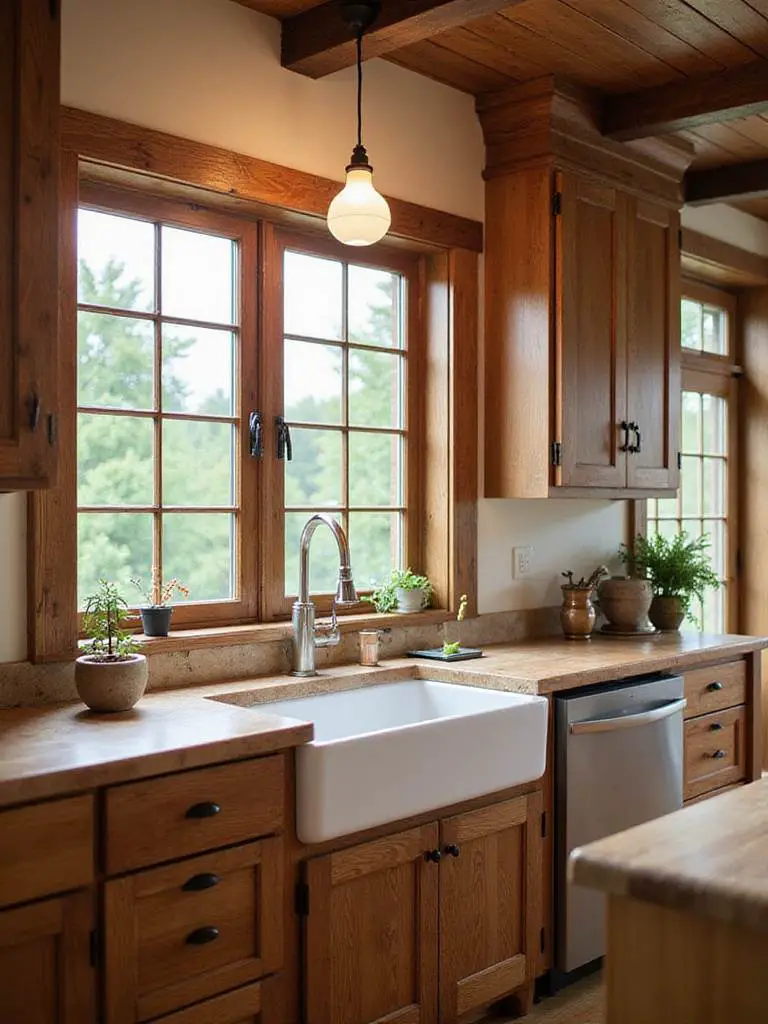
The practical benefits of wide-plank flooring extend beyond aesthetics to genuine performance advantages. Wider boards mean fewer joints where dirt and moisture can collect, making maintenance easier in a high-traffic kitchen environment. The substantial thickness of quality wide-plank flooring also provides excellent insulation and sound dampening, creating a more comfortable and quieter cooking environment. When properly finished with penetrating oils or low-sheen polyurethane, these floors develop a rich patina that actually improves with age and use.
Recommended wood species for kitchens:
- White oak for durability and classic grain patterns
- Reclaimed chestnut for unmatched character and stability
- Heart pine for warm color and historical authenticity
- Hickory for extreme durability in high-traffic areas
The sustainable journey of this material involves selecting lumber from responsibly managed forests or reclaimed sources that give new life to century-old timber.
5. Incorporate Exposed Brick for Textural Depth
The rough, honest texture of exposed brick walls brings an immediate sense of history and substance to any rustic kitchen design, creating a backdrop that feels both industrial and warmly organic. Whether you’re fortunate enough to have original brick walls hiding beneath plaster or you choose to install thin brick veneer, this material adds the kind of authentic character that takes other surfaces decades to develop. The natural color variations and weathered surface create visual interest that changes throughout the day as light shifts across its irregular surface.
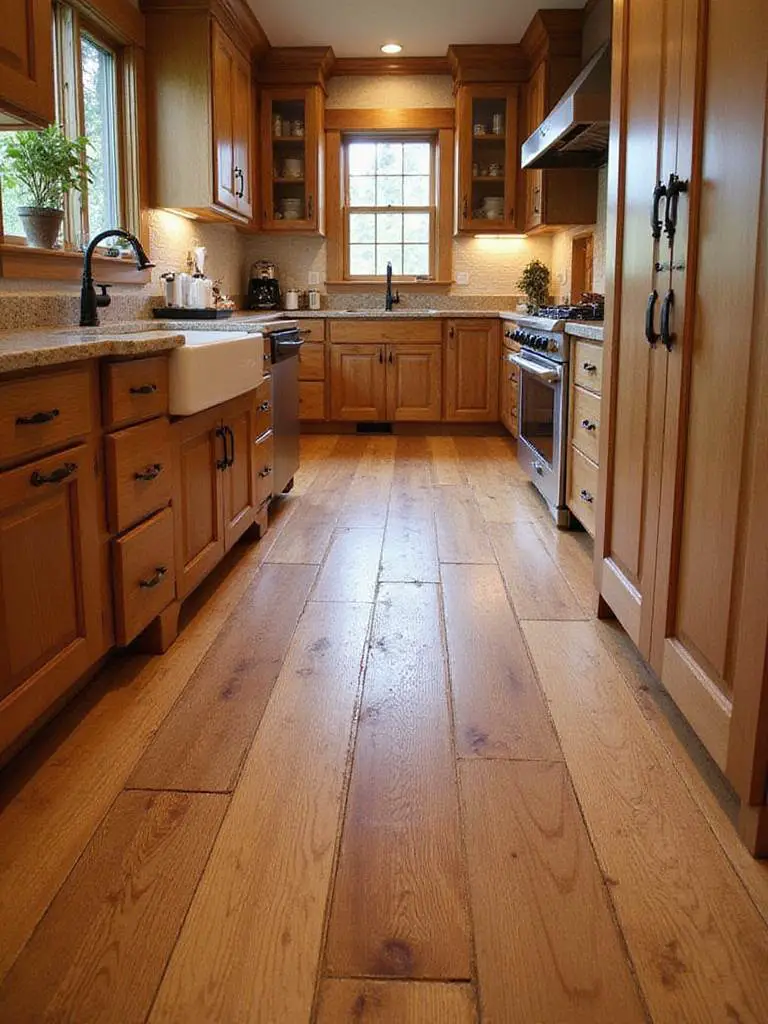
Exposed brick serves as more than just a design element – it’s a practical choice that offers excellent thermal mass, helping to moderate temperature fluctuations in your kitchen while providing natural sound absorption. The material’s durability means it can handle the humidity and temperature changes common in cooking spaces without deteriorating. When properly sealed, brick walls are surprisingly easy to maintain and actually improve with age, developing a deeper patina that enhances their rustic appeal.
The artisan collective that creates these pieces understands that authentic materials like brick connect us to generations of builders who valued permanence over convenience.
6. Design Open Shelving with Reclaimed Materials
Open shelving crafted from reclaimed barn wood or salvaged industrial materials transforms storage into display, allowing you to showcase the tools and treasures that make your kitchen uniquely yours. In rustic kitchen design, these exposed shelves serve a dual purpose – they provide easily accessible storage for daily essentials while creating opportunities to display handmade pottery, vintage preserving jars, and the herbs you’re growing on your windowsill. The organic irregularities of reclaimed wood add visual warmth that closed cabinetry simply cannot match.
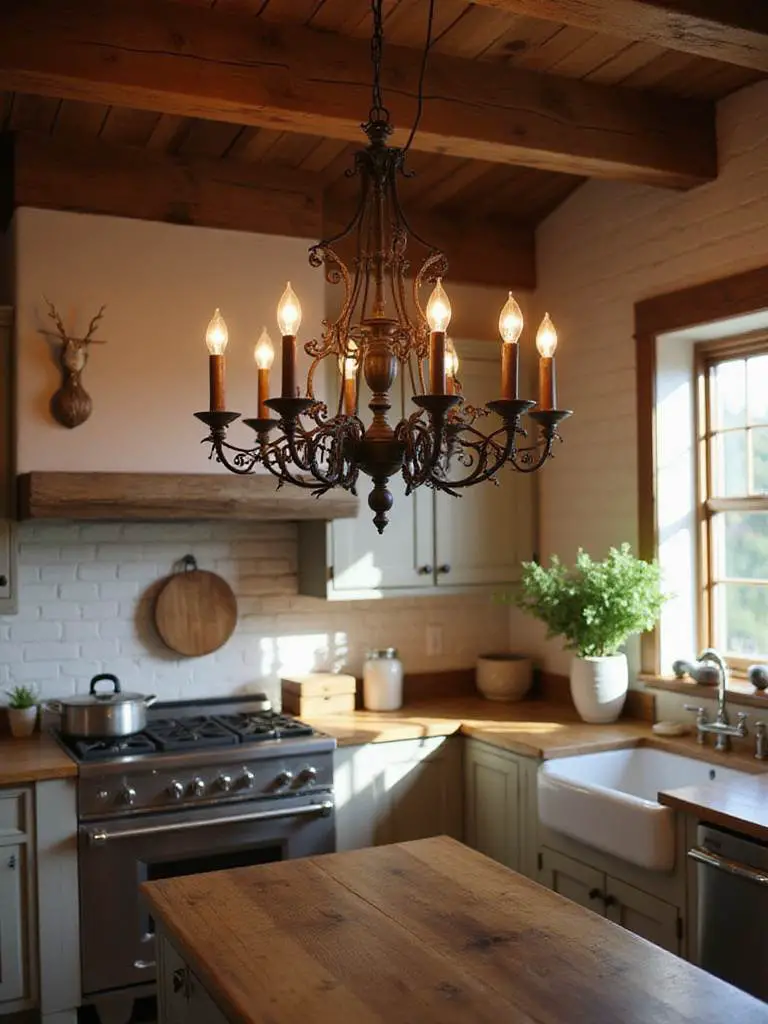
The functionality of well-designed open shelving extends beyond mere storage to become an integral part of your kitchen’s workflow. Frequently used dishes, spices, and cooking tools remain visible and within easy reach, while the open design prevents the accumulation of forgotten items that often hide in closed cabinets. The key is thoughtful curation – displaying only items that are both functional and beautiful, creating vignettes that tell the story of how you cook and live.
Essential elements for successful open shelving:
- Mix functional items with decorative pieces for visual interest
- Vary heights and textures to create dynamic compositions
- Include living elements like potted herbs or small plants
- Maintain organization to prevent cluttered appearance
Unlike mass-produced alternatives, this approach reduces waste by repurposing existing materials while creating storage solutions perfectly tailored to your specific needs.
7. Install a Statement Range Hood with Natural Materials
A thoughtfully designed range hood becomes the crown jewel of your rustic kitchen design, combining essential ventilation function with the opportunity to showcase natural materials and traditional craftsmanship. Whether crafted from reclaimed barn wood, hammered copper, or natural stone, a custom hood anchors the cooking area while providing the powerful ventilation needed for serious cooking. The substantial presence of a well-proportioned hood adds architectural weight that balances other large elements like islands or exposed beams.
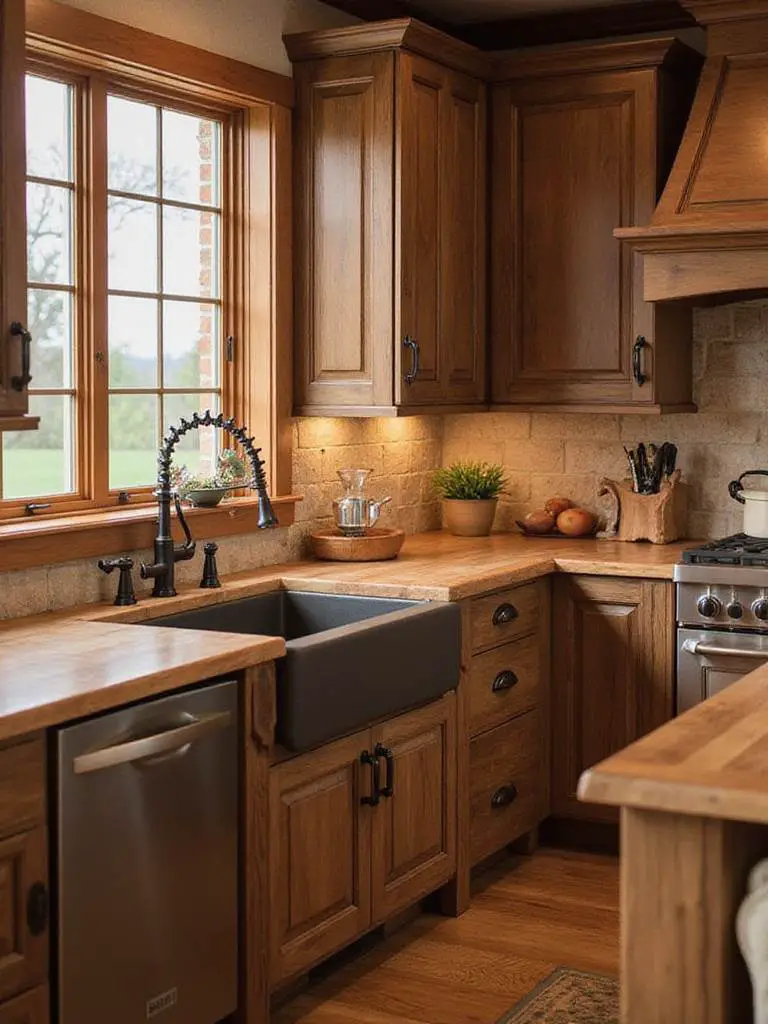
The practical importance of proper ventilation cannot be overstated, especially in kitchens where you’re doing serious cooking, canning, or food preservation. A quality range hood removes cooking odors, excess moisture, and airborne grease before they can settle on surfaces or affect air quality. When designed with rustic materials, these functional elements become beautiful focal points that demonstrate how form and function can work together harmoniously.
The third-generation workshop where this comes to life combines traditional joinery techniques with modern ventilation technology to create pieces that serve both practical and aesthetic purposes.
8. Create a Rustic Island with Integrated Growing Space
The kitchen island in a rustic design should feel like a piece of furniture that’s been in the family for generations – substantial, functional, and beautifully weathered. But why not take this concept further by integrating growing space directly into your island design? Built-in herb planters, pull-out growing trays, or even a small hydroponic system can transform your island from simple workspace to productive growing center. This approach aligns perfectly with the farm-to-table philosophy inherent in rustic design while providing the freshest possible ingredients for your cooking.
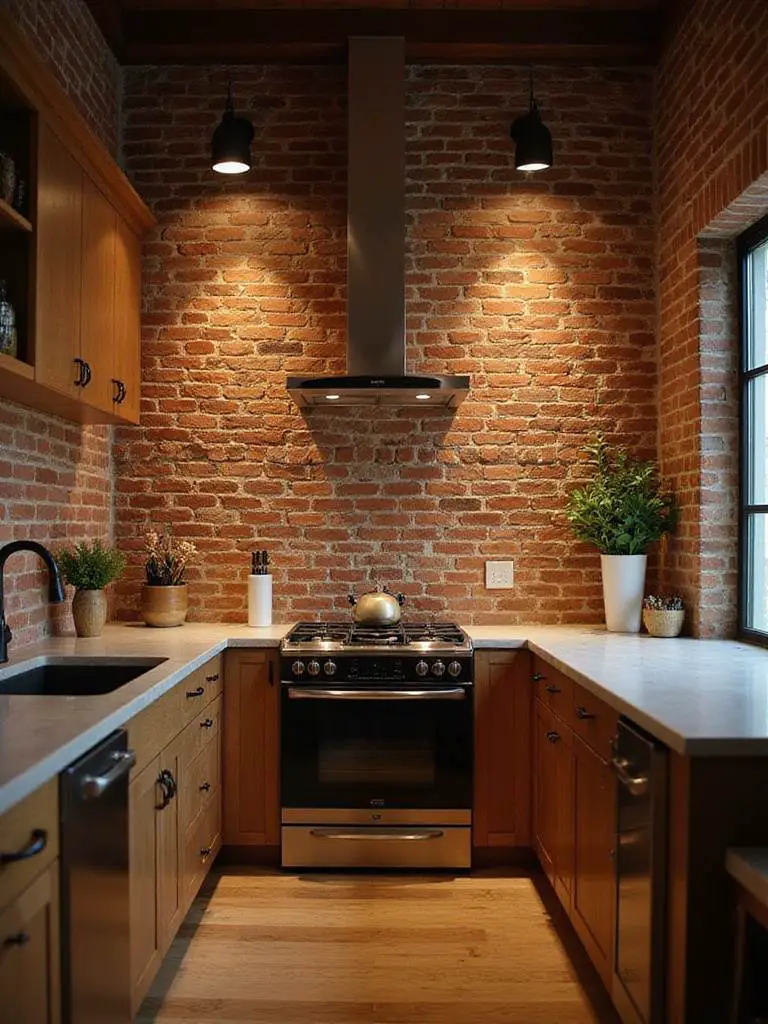
A well-designed island serves multiple functions beyond food preparation – it becomes a gathering place for family meals, homework sessions, and casual conversations. The integration of growing elements adds another dimension, creating opportunities to teach children about where food comes from while ensuring you always have fresh herbs and greens within arm’s reach. The natural progression from growing to harvesting to cooking all happens within the same space, embodying the self-sufficient spirit of traditional farmhouse kitchens.
Integrated growing features to consider:
- Built-in herb planters with proper drainage systems
- Pull-out growing trays for microgreens and sprouts
- LED growing lights hidden beneath upper cabinetry
- Compost collection drawer for kitchen scraps
The collaboration began with a conversation about how modern families can reconnect with food production even in urban environments.
9. Choose Natural Stone Backsplashes for Earthy Appeal
Natural stone backsplashes bring the raw beauty of the earth directly into your rustic kitchen design, creating a connection to the landscape that synthetic materials simply cannot replicate. Whether you choose the warm, varied tones of fieldstone, the subtle elegance of honed marble, or the rich texture of stacked slate, natural stone provides a backdrop that feels both timeless and deeply grounding. Each piece carries unique variations in color, texture, and veining that create visual interest while maintaining the organic feel essential to authentic rustic design.
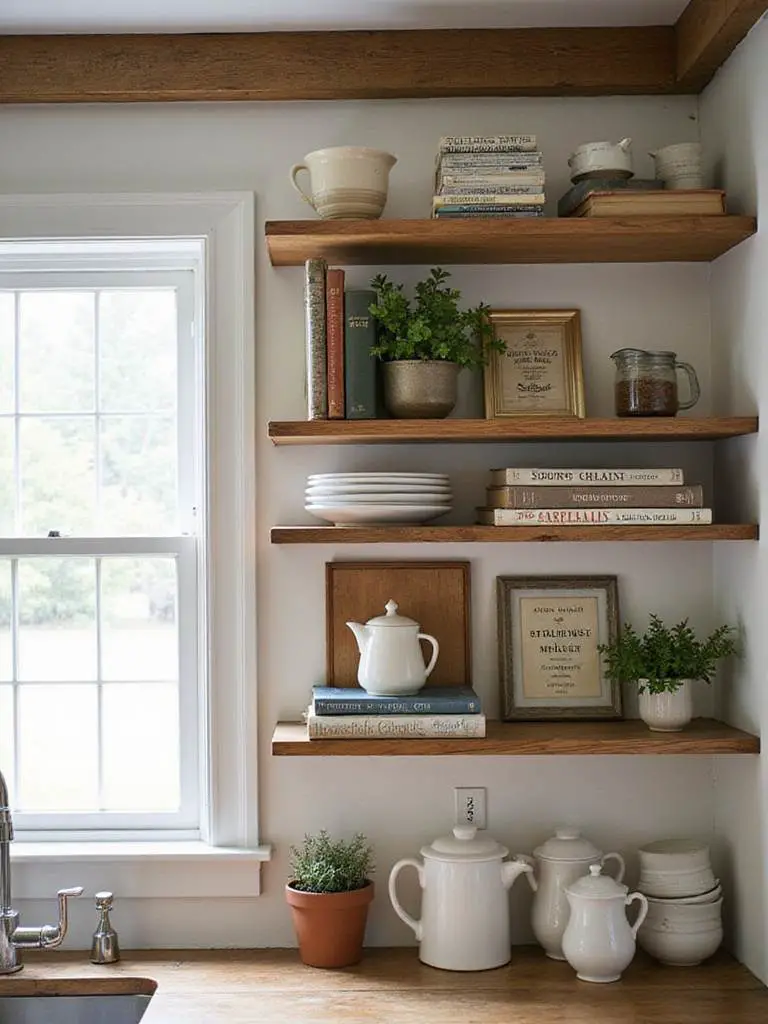
The practical benefits of stone backsplashes extend well beyond their natural beauty. Most natural stones are naturally resistant to heat, moisture, and staining when properly sealed, making them ideal for the demands of an active kitchen. The thermal mass of stone also helps moderate temperature fluctuations, and the natural variations in color and texture help camouflage the inevitable splashes and stains that occur during cooking. Unlike manufactured tiles, stone actually improves with age, developing a patina that enhances its character.
The materials are sourced from a remarkable region where geological processes over millions of years created the unique characteristics that make each installation completely individual.
10. Integrate Vintage-Style Lighting for Atmospheric Warmth
The right lighting can transform your rustic kitchen design from merely functional to genuinely magical, casting warm pools of light that invite gathering and create intimate corners for quiet conversation. Vintage-inspired fixtures – whether authentic antiques or quality reproductions – bring a sense of history and craftsmanship that modern lighting often lacks. Wrought iron chandeliers, mason jar pendants, or industrial-style cage lights create focal points while providing the layered illumination essential for both cooking tasks and atmospheric dining.

Understanding how light interacts with natural materials throughout the day is crucial for creating a truly welcoming space. Warm-toned LED bulbs in vintage-style fixtures cast light that enhances the grain in wood surfaces, brings out the depth in stone textures, and creates the kind of golden glow that makes everyone look and feel better. The key is layering different types of lighting – ambient fixtures for overall illumination, task lights for work areas, and accent lighting to highlight special features or collections.
The designer’s secret here is to consider how lighting changes the emotional temperature of your space, making it feel more intimate and welcoming as the day progresses into evening.
11. Install Shiplap or Beadboard for Textural Interest
The clean lines and subtle texture of shiplap or beadboard wainscoting add architectural interest to rustic kitchen design while connecting your space to the vernacular building traditions of rural America. These horizontal or vertical planks create visual rhythm and depth while providing practical protection for wall surfaces in high-traffic areas. The slight shadows created by the overlapping boards add dimension that changes throughout the day as natural light shifts, creating a dynamic backdrop for your kitchen activities.
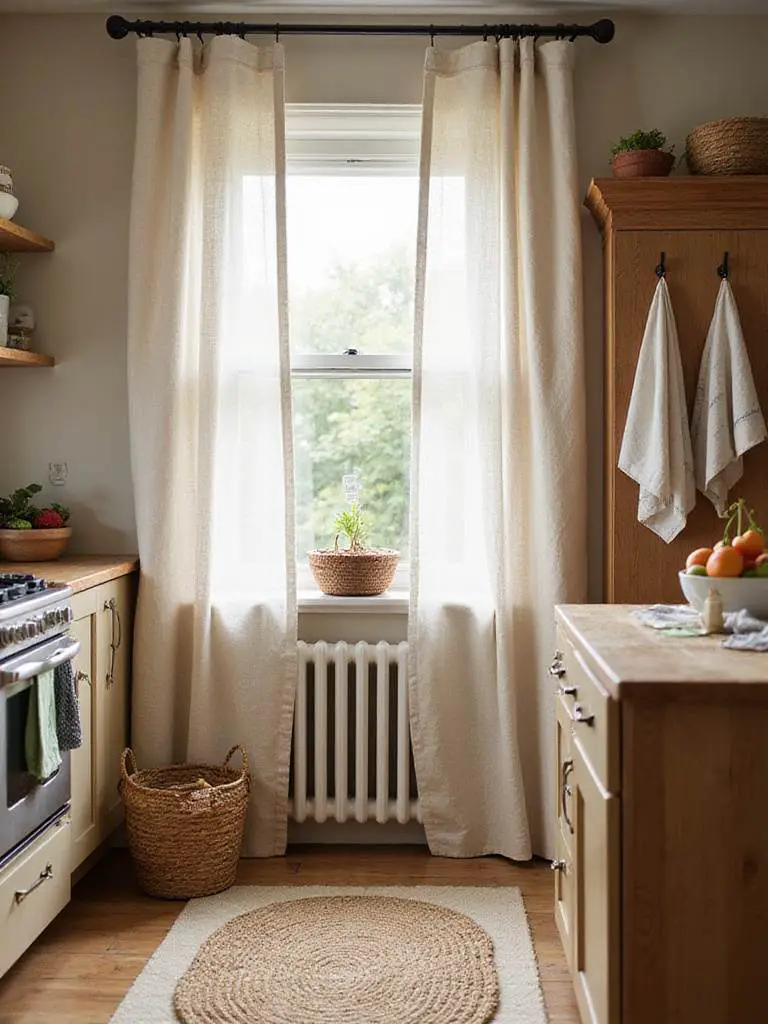
Traditional shiplap and beadboard were originally functional solutions – ways to create tight, weatherproof walls using available materials and simple tools. Today, these techniques bring that same honest, unpretentious character to modern kitchens while offering practical benefits like easy repair and refinishing. The natural expansion and contraction of wood boards also provides some flexibility that can prevent cracking in older homes that experience seasonal movement.
Installation considerations:
- Choose sustainably harvested or reclaimed wood when possible
- Allow for proper expansion gaps to prevent buckling
- Use moisture-resistant finishes in areas near sinks or stoves
- Consider vertical installation to make ceilings appear higher
The revival of this classic form comes with a twist – modern milling techniques allow for more precise fits while maintaining the handcrafted appearance.
12. Incorporate Copper Accents for Living Patina
Copper brings a warm, living quality to rustic kitchen design that few other materials can match – it literally changes and evolves with use, developing a unique patina that tells the story of your kitchen’s daily life. Whether incorporated through cookware displays, sink basins, range hoods, or decorative accents, copper adds richness and depth while connecting your space to traditional foodways where copper pots were treasured tools passed down through generations.
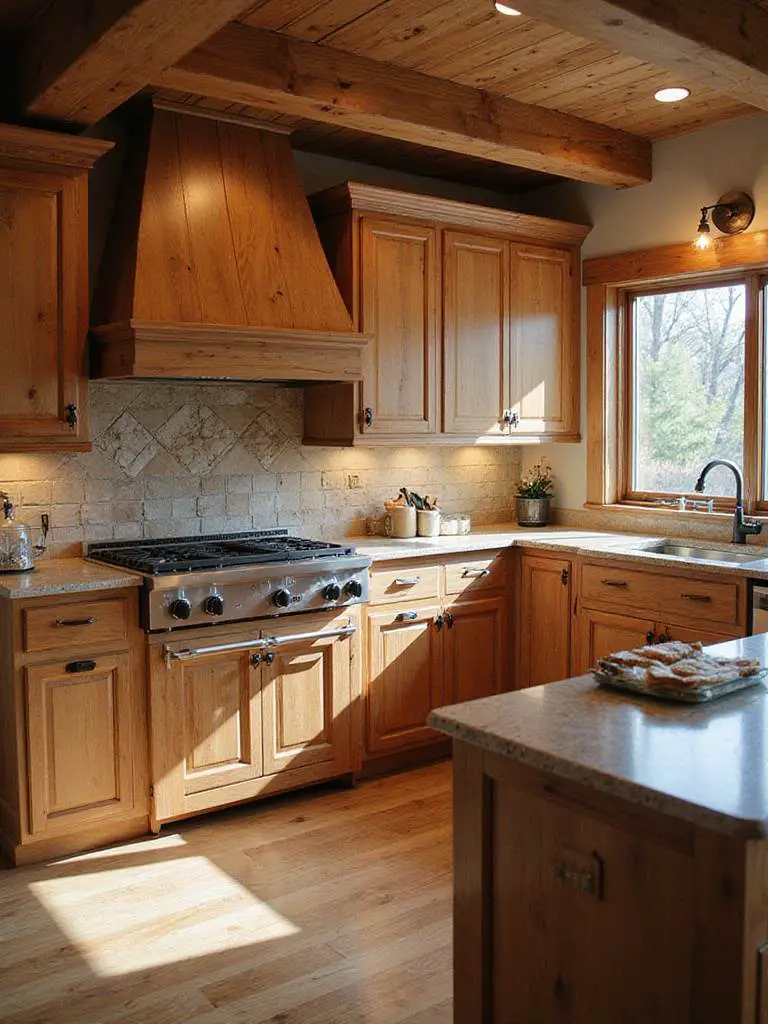
The antimicrobial properties of copper make it particularly well-suited for kitchen applications, naturally inhibiting bacteria and other microorganisms on contact. This practical benefit, combined with copper’s excellent heat conductivity and durability, explains why professional chefs have long preferred copper cookware. In rustic design, the metal’s ability to develop different patinas depending on use and environment means that each installation becomes unique over time.
The environmental benefit comes from copper’s complete recyclability and the fact that many copper elements can be crafted from reclaimed materials, reducing the need for new mining.
13. Design Built-In Banquette Seating with Storage
Built-in banquette seating transforms an underutilized corner into a cozy dining nook while maximizing both seating capacity and storage potential in your rustic kitchen design. These custom-fitted benches, often constructed with the same materials as your cabinetry, create an intimate dining experience that encourages lingering conversations over meals. The integration of storage within the bench construction provides valuable space for linens, seasonal items, or kitchen equipment that doesn’t need daily access.
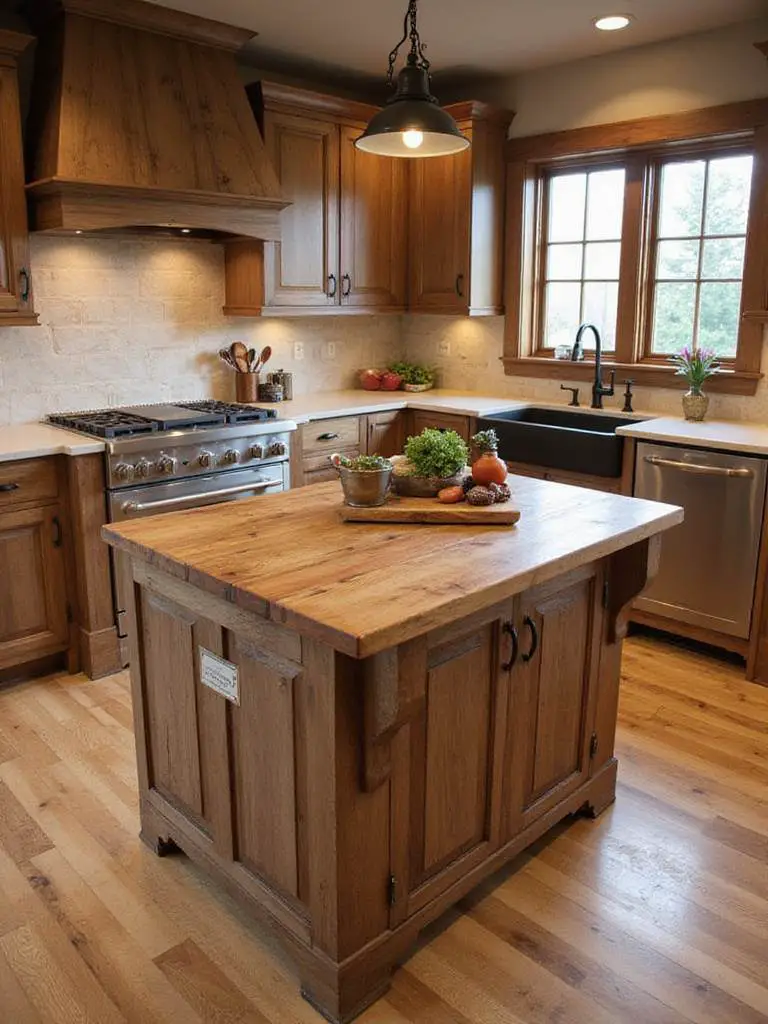
The space efficiency of banquette seating is remarkable – you can typically seat 25% more people in the same footprint compared to traditional chairs, while the built-in nature eliminates the need for chair clearance behind the seating. This makes banquettes particularly valuable in smaller kitchens where every square foot matters. The cozy, enclosed feeling created by banquette seating also makes meals feel more intimate and special, encouraging families to linger and connect over food.
The craftsman’s attention to detail shows in elements like the careful fitting of cushions, the smooth operation of storage compartments, and the integration with surrounding cabinetry.
14. Select Matte Black Hardware for Modern Contrast
The deep, sophisticated tone of matte black hardware provides striking contrast against natural wood surfaces while maintaining the authentic feel essential to rustic kitchen design. This finish offers a contemporary edge that prevents rustic elements from feeling dated while providing the visual weight needed to ground lighter wood tones and natural textures. Unlike shiny finishes that can feel sterile, matte black hardware develops subtle character over time while hiding fingerprints and daily wear.
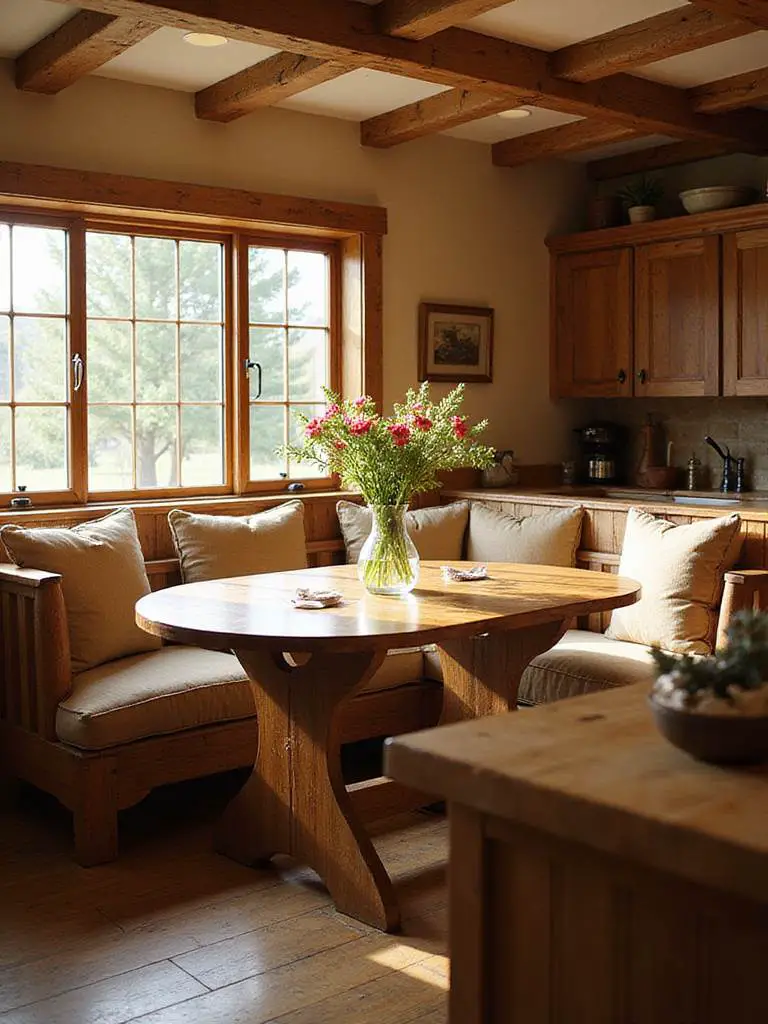
The versatility of matte black allows it to work beautifully with both warm and cool color palettes, making it an ideal choice for kitchens that blend rustic elements with more contemporary features. This finish complements the industrial aspects of rustic design while providing enough contrast to make cabinet lines and architectural details more defined. The substantial appearance of quality black hardware also signals attention to detail and investment in lasting materials.
Hardware selection tips:
- Choose substantial, well-weighted pieces that feel solid in hand
- Consider mixing knobs and pulls for visual interest
- Ensure consistent finish quality across all pieces
- Select styles that complement your cabinet door profiles
What surprises clients most is how this works with both traditional and contemporary elements, serving as a bridge between different design periods.
15. Create Herb Growing Stations Near Windows
Integrating dedicated herb growing stations into your rustic kitchen design brings the garden indoors while ensuring fresh seasonings are always within reach of your cooking area. Position these growing spaces near south-facing windows where herbs can receive adequate natural light, or supplement with full-spectrum LED growing lights hidden beneath upper cabinets. This approach embodies the self-sufficient spirit of traditional farmhouse kitchens while providing the freshest possible ingredients for your meals.
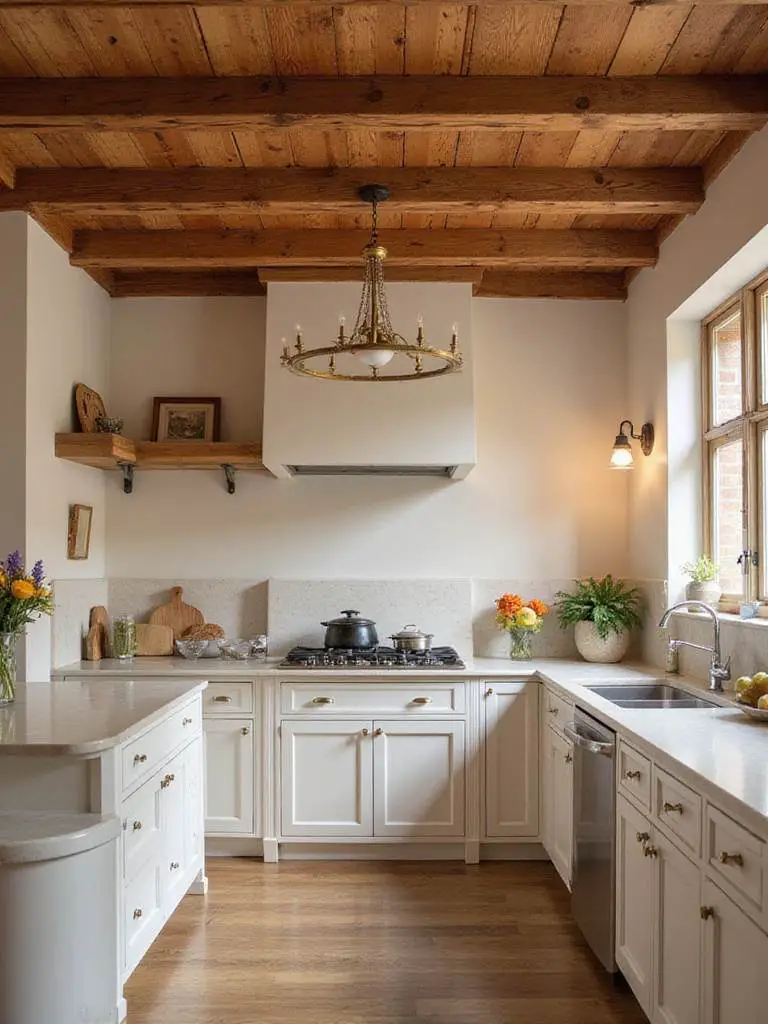
The practical benefits of indoor herb cultivation extend beyond convenience to include better flavor, reduced grocery costs, and the satisfaction of growing your own food. Many culinary herbs actually prefer the controlled environment of indoor growing, producing more tender leaves and stronger flavors than their outdoor counterparts. The visual appeal of healthy, growing plants also adds life and color to your kitchen while improving air quality through natural filtration.
Best herbs for kitchen growing:
- Basil for continuous harvest and aromatic appeal
- Mint varieties for teas and cocktails (contained to prevent spreading)
- Parsley for steady production and nutritional value
- Thyme and oregano for Mediterranean cooking
The unexpected environmental benefit comes from reducing packaging waste and transportation impacts associated with store-bought herbs.
16. Install Sliding Barn Doors for Space-Saving Style
Sliding barn doors bring authentic agricultural character to rustic kitchen design while solving practical space constraints that traditional hinged doors cannot address. These substantial wood panels, mounted on exposed metal tracks, add architectural interest while providing flexible access to pantries, laundry areas, or dining spaces. The horizontal wood grain and substantial hardware create strong visual lines that complement other rustic elements while serving as functional art pieces.
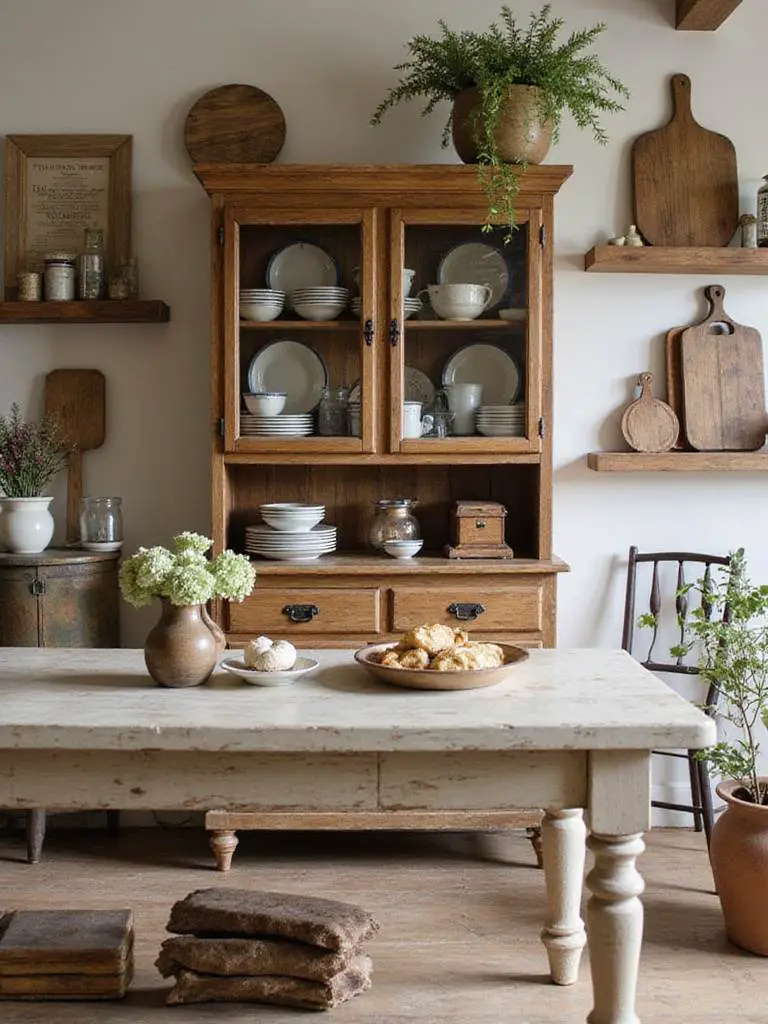
The space-saving benefits of barn doors are particularly valuable in kitchen applications where every square foot of floor space matters. Unlike traditional doors that require clearance for opening, sliding doors move along the wall surface, allowing you to place furniture or appliances closer to doorways. The substantial construction of quality barn doors also provides better sound insulation than standard hollow-core doors, helping to contain kitchen noise.
The traditional methods used result in doors that can support their own weight while operating smoothly for decades with minimal maintenance.
17. Incorporate Live-Edge Wood Elements for Organic Beauty
Live-edge wood elements – pieces that retain the natural, uncut edge of the original tree – bring unparalleled organic beauty to rustic kitchen design by showcasing nature’s own artistry. Whether used for floating shelves, breakfast bars, or decorative accents, these pieces celebrate the natural form of trees while adding unique character that cannot be replicated or mass-produced. Each live-edge piece tells the story of the tree it came from, complete with the growth patterns, weather marks, and natural variations that make it one-of-a-kind.
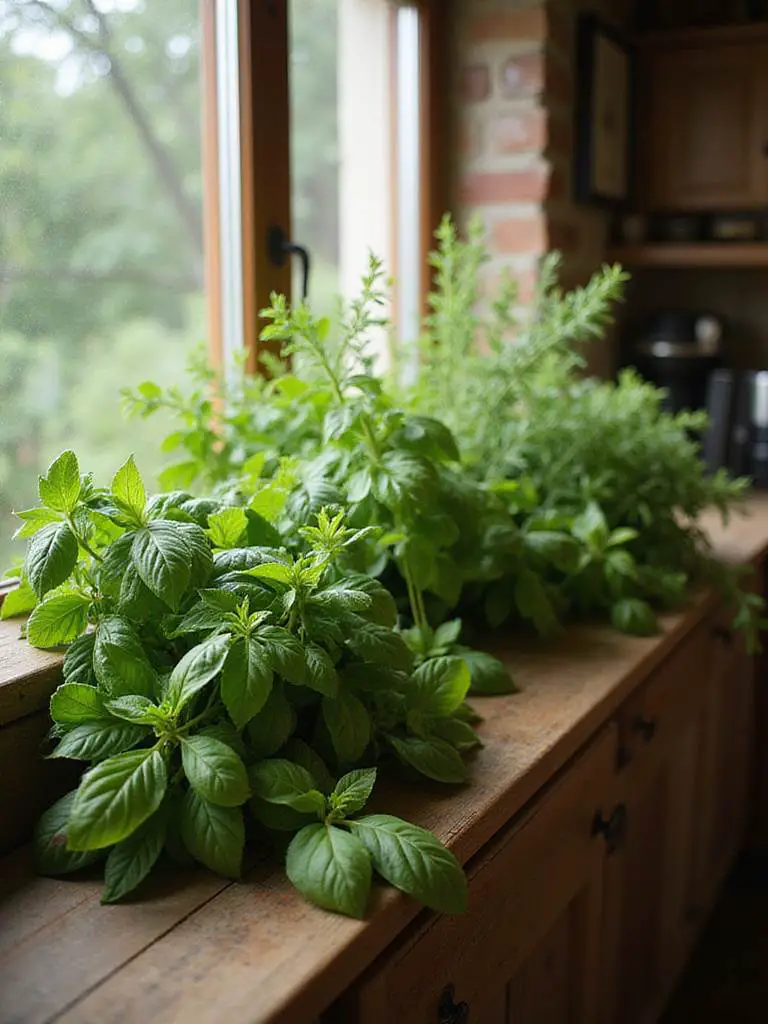
The integration of live-edge elements requires careful consideration of their placement and treatment to ensure they enhance rather than overwhelm your kitchen design. These pieces work best as accent elements that draw the eye and create focal points, rather than as primary surfaces that might be impractical for daily use. Proper finishing is essential to protect the wood while maintaining its natural character, typically involving multiple coats of penetrating oil or clear finish that enhances the grain without obscuring it.
The forest where this walnut grew stands just 90 miles from our workshop, part of our commitment to sourcing materials that travel less while supporting local forest management.
18. Design a Coffee Station with Rustic Charm
A dedicated coffee station designed with rustic charm transforms your morning routine into a mindful ritual while creating a functional focal point within your kitchen design. Built from reclaimed wood with open shelving for mugs and supplies, integrated storage for beans and equipment, and proper electrical placement for brewing devices, this specialized area brings café-style convenience to your home. The warmth of natural wood and the display of beautiful coffee-making tools create an inviting corner that draws people together.
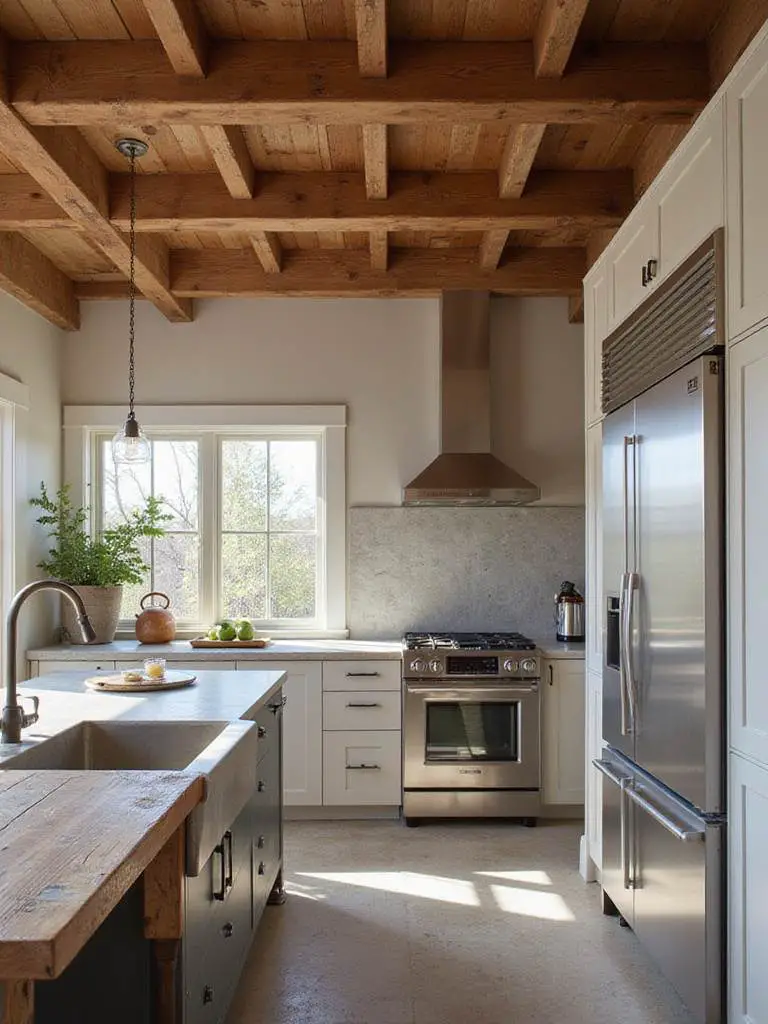
The practical organization of a well-designed coffee station streamlines your morning routine while keeping countertops clear of small appliances and supplies. Dedicated storage for different types of beans, filters, and brewing equipment ensures everything has its place while remaining easily accessible. The integration of a small sink or water line can further enhance functionality, though careful planning is required to ensure proper drainage and electrical safety.
Essential coffee station elements:
- Dedicated electrical circuits for multiple appliances
- Open storage for frequently used mugs and supplies
- Enclosed storage for beans and specialty equipment
- Task lighting for early morning use
- Easy-to-clean surfaces that handle daily spills
As morning light filters through, the texture creates a warm, welcoming atmosphere that makes the first cup of coffee feel like a special moment rather than just another daily task.
Conclusion
Creating an authentic rustic kitchen design is about more than just selecting weathered materials and vintage accessories – it’s about crafting a space that honors our connection to the natural world while supporting the rhythms of daily life. These 18 ideas work together to create kitchens that feel genuinely lived-in, where the patina of use adds beauty rather than detracting from it, and where the integration of growing elements brings the cycle of cultivation and nourishment full circle.
The beauty of rustic design lies in its celebration of imperfection and its embrace of materials that improve with age and use. By choosing reclaimed wood, natural stone, and living elements, you’re creating a kitchen that will develop character over time rather than simply wearing out. The integration of growing spaces – whether herb gardens, sprouting stations, or composting systems – connects your kitchen to the larger cycles of nature while providing the freshest possible ingredients for your family’s meals.
Your kitchen should be a place where the boundaries between indoor and outdoor living blur, where the tools of food preparation are as beautiful as they are functional, and where every meal connects you to the land that sustains us all. Start with one or two elements that speak to you most strongly, and let your rustic kitchen design evolve naturally as you discover what works best for your family’s unique way of living and eating.
